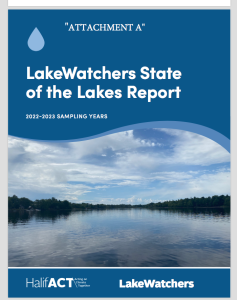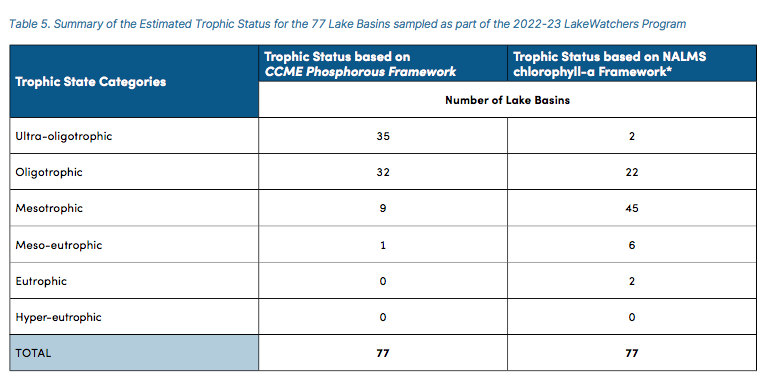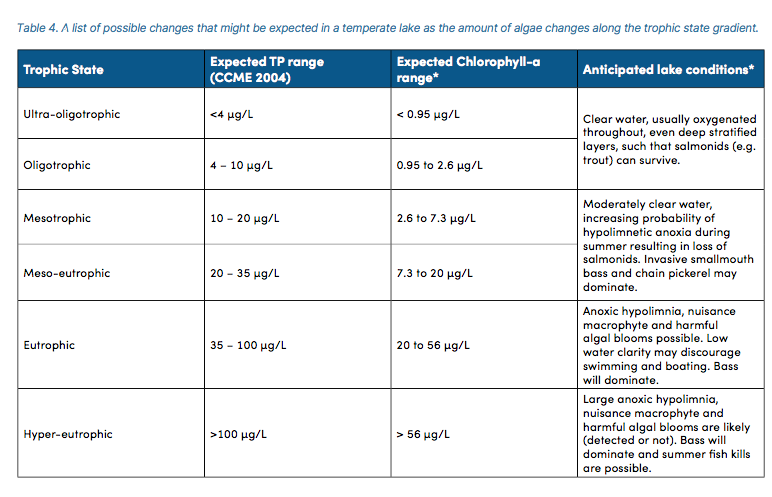 The LakeWatchers Report is highly informative, exceptionally well presented, and very timely. In general our results and interpretations of them for Sandy Lake as reported on this website are consistent with the conclusion from the LakeWatchers conclusion that “that most Halifax-area lakes currently suffer from some level of chloride enrichment and show signs of increasing eutrophication.” I was particularly interested in the recognition and discussion of a “Total P measurement issue” (my terminology), the recently measured values seeming to be too low in relation to historical values and to other indicators of trophic status.
The LakeWatchers Report is highly informative, exceptionally well presented, and very timely. In general our results and interpretations of them for Sandy Lake as reported on this website are consistent with the conclusion from the LakeWatchers conclusion that “that most Halifax-area lakes currently suffer from some level of chloride enrichment and show signs of increasing eutrophication.” I was particularly interested in the recognition and discussion of a “Total P measurement issue” (my terminology), the recently measured values seeming to be too low in relation to historical values and to other indicators of trophic status.
The LakeWatchers Report is included as “Attachment A, for Item No. 13.1.2, Environment & Sustainability Standing Committee October 03, 2024: Subject: LakeWatchers Water Quality Monitoring Program Report 2022-2023.
The Executive Summary for Item No. 13.1.2 provides a concise summary of the Report:
EXECUTIVE SUMMARY
The “State of the Lakes” Report (Attachment A) provides an in-depth analysis of the 2022-23 LakeWatchers program, which was initiated to monitor the water quality of 73 lakes in the Halifax Regional Municipality (HRM). The report outlines the key findings of the LakeWatchers Program related to the current baseline conditions of the lakes, focusing on eutrophication, chloride enrichment, and bacterial contamination.The LakeWatchers Program actively engages and involves community groups and volunteers in water quality monitoring, setting it apart from a previous municipal water quality monitoring program (2006-2011) which relied solely on consultants. The LakeWatchers program was launched in the spring of 2022. The number of lakes in which community groups and volunteers have participated has grown to include 30 of 73 lakes as of August 2023.
While the 2022-23 LakeWatchers data detected lower phosphorus levels compared to the 2006-2011 HRM Lake Water Quality Monitoring Program (LWQMP), further analysis of other parameters maintains that Halifax-area lakes are experiencing a rise in nutrient levels over time. These results were consistent between both lakes sampled by volunteers and consultants. Duplicate samples will be collected in 2024 to further investigate.
Additionally, most lakes displayed consistently elevated deepwater chloride levels, with some in exceedance of federal guidelines for long-term exposure intended to protect freshwater aquatic life. These elevated chloride levels pose a significant threat to the biodiversity of freshwater ecosystems within the HRM and have the potential to disrupt the natural mixing cycle of lakes.
Lastly, there were very few (<1%) instances of E. coli detected above Health Canada guidelines which suggests that E. coli is not a lake wide concern and instead impacts near-shore beaches.
Overall, the initial findings of the LakeWatchers Program indicate that most Halifax-area lakes currently suffer from some level of chloride enrichment and show signs of increasing eutrophication. These findings align with previous studies and emphasize the importance of monitoring to inform proactive measures to protect lake water quality in the municipality.
The Executive Summary is followed by these three recommendations:
1. Direct the Chief Administrative Officer to initiate a review of the Municipality’s current Salt Management Plan guided by the Syntheses of Best Practices Road Salt Management.
2. Direct the Chief Administrative Officer to investigate policy options for setbacks for new stormwater discharge locations into natural waterbodies and consider options for naturalization and/or Low Impact Development (LID) features at existing stormwater discharge locations around priority lakes.
3. Request that the Mayor write a letter to the Province of Nova Scotia’s Minster of Environment and Climate Change and the Halifax Regional Water Commission, supporting and encouraging the timely development of provincial stormwater quality standards.
Some further Background and Discussion of the Report are given on pages 2-12 of the Item No. 13.1.2 document that precede the report itself.
Sandy Lake (Bedford) is #23 of 76 lakes listed; apparently there were 73 lakes initially and 4 more have since been added. For 30 of the lakes (including Sandy Lake), volunteers conduct the lake sampling.
In general our results and interpretations of them for Sandy Lake as reported on this website are consistent with the conclusion from the LakeWatchers results that “most Halifax-area lakes currently suffer from some level of chloride enrichment and show signs of increasing eutrophication.”
I was particularly interested in the discussion in the Lakewatchers’ Report, pp 26 and 32-33, of apparent inconsistencies between TP (Total Phosphorus) values for 2022-23 with what we would be expected based on historical measurements under the WOMP program (2006-11); it was expected the values in 2022-23 would be higher overall, but they were actually lower. As well they noted:
The trophic status estimates provided by the LakeWatchers surface TP results also did not show close alignment between the observed chlorophyll-a concentrations for the same 2022-23 period. [Table 5, below] In fact, the LakeWatchers chlorophyll-a results provided trophic status estimates that were more consistent with the estimates provided by the surface TP values observed in the 2006-2011 WQMP.
 They discuss the possible reasons for these apparent discrepancies, and are conducting followup investigations.
They discuss the possible reasons for these apparent discrepancies, and are conducting followup investigations.
I had wondered about the seemingly low Total P Total P in the spring turnover sampling of Sandy Lake in 2022, commenting
Total P in the spring turnover sampling of 2022, measured under the LakeWatchers Program was only 6 ug/L (well within in the oligotrophic range) yet the deep water oxygen in the Aug. sampling was 1.3 ug/L. Given the trends of Total P documented in AECOM (2014), we might wonder whether the 6ug/L figure is suspect.
This table is given on page 25 of the LakeWatchers report:
 Below are our Total P (spring) and Chlorophyll-a (late summer) values for samples from Sandy Lake collected in collaboration with the LakeWatchers Program:
Below are our Total P (spring) and Chlorophyll-a (late summer) values for samples from Sandy Lake collected in collaboration with the LakeWatchers Program:
| Year | Total P | Chl-a |
| 2022 | 5.3 | 5.2 |
| 2023 | 10 | 2.8 |
| 2024 | 6.6 | – |
So Sandy Lake is one of a large set of lakes in the LakeWatchers program that had Total P values placing it the Oligotrophic state, while the Chlorophyll-a and low late summer deep water oxygen values would place it in the Mesotrophic state.
Because of the routine use of Total P measurements to assess water quality in HRM, not just in lakes, but also in streams and in relation to ongoing development. I hope this “Total P measurement issue” is flagged by HRM in these other regards. For example in the Bedford West Water Quality Status Update – Summer 2023, the August 27, 2023 Total Phosphorus values for 10 sample locations were in the range 7-8 μg/L, while the Acceptable Phosphorus Concentration was 10 μg/L, so it was concluded that “No exceedances of the 10 μg/L phosphorus were noted at this sampling event.” It’s not a trivial matter as under the BWPS (Bedford West Planning Strategy), exceedance of 10 μg/L triggers some remedial actions/improved practices.
There’s lots more to chew on in the LakeWatchers Report related to Sandy Lake specifically, and HRM lakes more generally.
The LakeWatchers Report is highly informative, exceptionally well presented, and very timely.
Thx LakeWatchers, HRM
